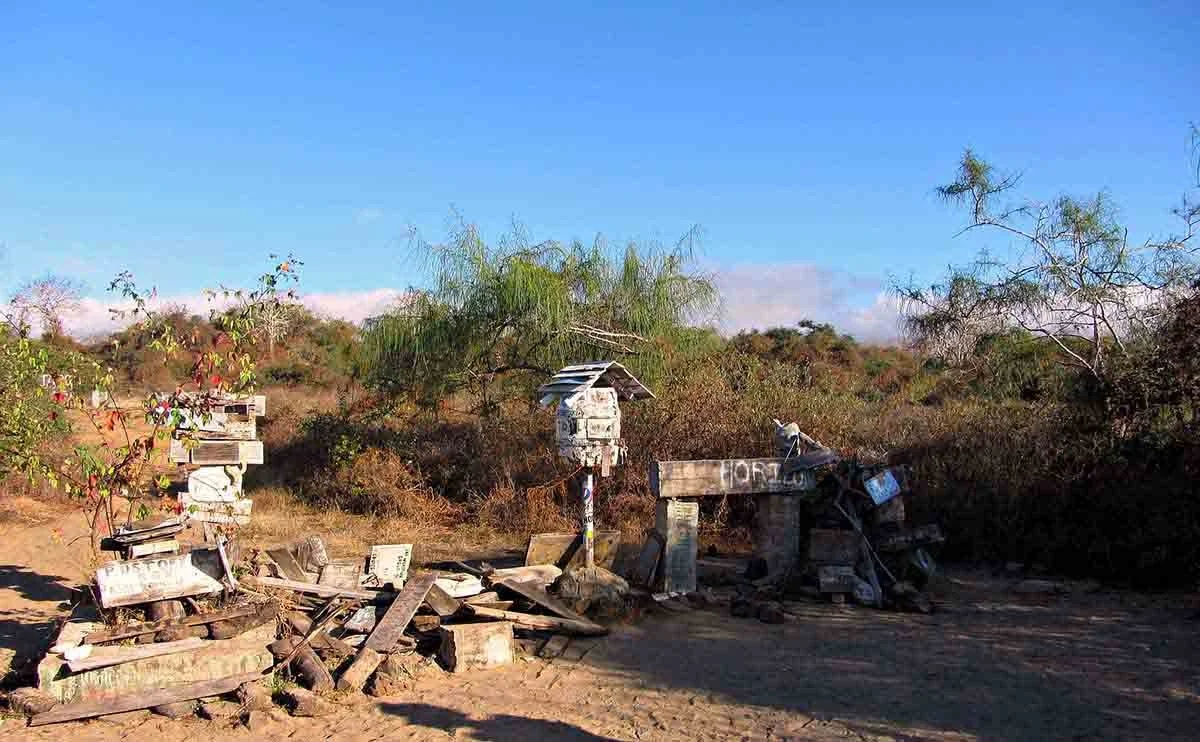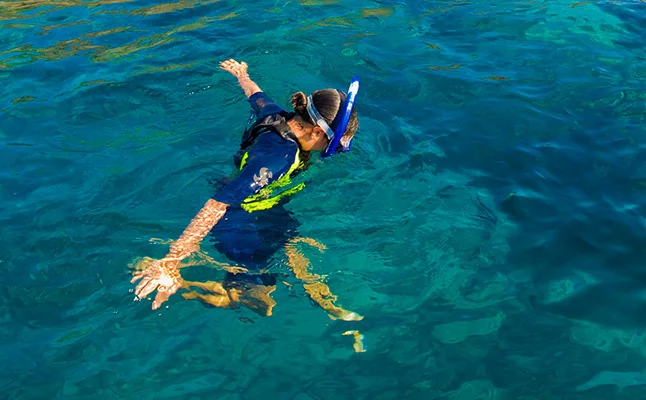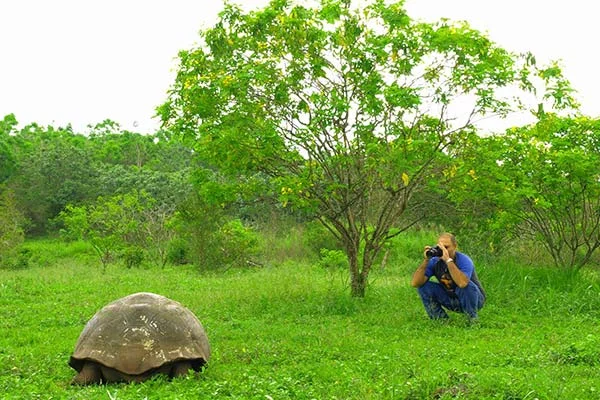
Galapagos Islands Human History
An abandoned Irishman is considered the first settler in the archipelago
19th Century – The First Inhabitant: Patrick Watkins
Curious about the human history of the Galapagos? At the beginning of the 19th century, an Irish sailor was abandoned on Charles Island (Floreana), his name was Patrick Watkins and he is considered to be the first inhabitant of the Galapagos Islands.
He cultivated vegetables, which he traded to the whalers for rum and several years later managed to obtain a boat and recruit a few men which he took to sea in hopes of returning to dry land. Strangely he arrived at Guayaquil alone and then went to Patia where he convinced a mulatto woman to accompany him back to the island. He spent the rest of his days in prison after being arrested while trying to steal a ship.

- 1485 – The first visitors were sailors of the Chimu culture from northern Peru during the rule of the great Inca, Tupac Yupanqui.
- 1535 – The official discovery of Galapagos, on March 10th, by Fray Tomas de Berlanga, a Spanish Bishop, aboard a ship pushed off course by ocean currents while sailing from Panama to Peru.
- 1570 – The Galapagos Islands appear for the first time on a world map. They are called “Insulae de los Galopegos.’
- 1593 -1710 – Use of the Galapagos by pirates as refuge and supply base for water and meat (particularly the giant tortoises). Introduction of goats and dogs to the islands.
- 1793 -1870 – Period of whale exploitation in the Islands threatening populations of tortoises, fur seals and whales.
- 1793 – Erection of the post office barrel on Floreana to facilitate delivery to the United States and Europe.
- 1800 -1900 – The exploitation of fur seals by North Americans and Europeans almost causing Galapagos Fur seal
extinction. - 1832 – Ecuador officially claims Galapagos calling it “Archipelago del Ecuador.” Islands are given their Spanish names.
- 1835 – Visit of the H.M.S. Beagle to Galapagos for five weeks, from September 15 to October 20. During this period, Charles Darwin visited San Cristobal, Santiago, Floreana and Isabela Islands. The Captain, Robert Fitzroy, drew up accurate navigation charts.
- 1841 – U.S. writer Herman Melville visits Galapagos. He later wrote an articulate account of his experience in “Las Encantadas.”
- 1859 – Publication of Charles Darwin’s The Origin of Species which brought recognition to Galapagos as a natural laboratory for evolution.
- 1892 – Galapagos is officially named “Archipelago de Colon” in honor of Christopher Colombus’s discovery of America 400 years earlier.
- 1905 – 1906 – Scientists from the California Academy of Science make extensive collections and studies of the islands.
- 1923 – Visit by American William Beebe, whose book Galapagos World’s End, gave worldwide fame to the Islands.
- 1926 – Group of Norwegians arrive in Galapagos. Some still remain today on Santa Cruz farming in the highlands.
- 1934 – First legislation to protect Galapagos fauna is passed. Mysterious events surround the disappearance of the Baroness Van Wagner and a companion, and the deaths of others on Floreana,
- 1941- 1948 – Construction and occupation of an air base on Baltra by the U.S. and the extinction of land iguanas on that island.
- 1959 – On July 4th, the government declares all areas of Galapagos as National Park except for the colonized areas. The Charles Darwin Foundation is founded in Brussels on July 23rd. Its first President is Victor Von Staelen.
- 1964 – The Darwin Station is inaugurated in the presence of many national and international authorities.
- 1968 – Administration of the Galapagos National Park Service begins.
- 1969 – Large-scale tourism begins in Galapagos with the arrival of the LINA-A, a ship carrying 58 passengers.
- 1971 – Lonesome George is found on Pinta Island, the last of his breed.
- 1972 – Japanese fishing ships capture hundreds of sea turtles.
- 1974 – The first master plan for the protection and management of the Galapagos National Park is published.
- 1978 – The Islands are declared a World Heritage site by UNESCO underlining its universal value for mankind. o
- 1986 – The Galapagos Marine Resources Reserve is signed into law by President Leon Febres Cordero to protect the waters 15 miles offshore.
- 1992 – A new revised, long-term master plan for the development and management of the CDRS, which will provide guidelines for the Station’s programs and gradual growth to its full potential.
- 1994 – A fire in Isabela Island causes damage to 20,000 square miles near Volcano Sierra Negro. 70-80 tortoises are slaughtered by fisherman in protest of the governments indecision to lift a ban on commercialized fishing.
- 1995 – Isabela threatened by introduced plants and animals and overgrazing by goats.

Kurt Vonnegut and other mussings about Galapagos prehistory
Based on the ancient archeological remains found in the Ecuadorian coast, it was said that the land was first inhabited by sailors who arrived on floating crafts called “Balsas”. They used sailing techniques to move far out in the sea and perhaps arrived at the Galapagos Islands. However, there is no trace of their permanent settlement there, which leads to the conclusion that all those trips were possibly accidental trips.
There are speculations about the Inca culture, making an early journey to the Galapagos Islands in 1400. The Enchanted Isles were first discovered by Spanish Fray Tomás de Berlanga, who was the fourth bishop of Panama. He sailed first to Peru to resolve a clash between Francisco Pizarro and his lieutenants. But the diminished winds drifted the vessel off track, making the parties reach Galapagos on March 10, 1535. A study was conducted by Arne Skjølsvold and Thor Heyerdahl in 1952; it was conducted on the basis of the artifacts and remains of potsherds found in numerous sites. The study suggested that these islands were visited by South Americans prior to Spanish. However, the theory was written off because of the absence of ceremonial vessels, graves, or any kind of construction suggesting permanent settlement.
Visited by Incas?
The islands initially came into view on the maps of Abraham Ortelius and Gerardus Mercator in 1570. These were initially named “Insulae de los Galopegos” or the “Islands of the Tortoises” because of the existence of giant Galapagos Tortoises.
The first English discovery of the islands was by Richard Hawkins in 1593. The archipelago (see map ) was seen mostly as a hideout by English pirates who stole Spanish galleons, shipping silver and gold from South America to Spain.
In 1793, James Colnett described the flora as well as the fauna of the islands, suggesting that the place could be utilized as a base for the whalers working in the Pacific Ocean. The first permanent human resident on the islands was an Irish sailor named Patrick Watkins, who remained there during 1807–1809. He grew vegetables and traded with whalers before finding a boat and sailing to Guayaquil. Herman Melville, the author of the Moby–Dick fame, paid a visit to these islands, on a whaler. He recounted his experiences in one of his stories, The Encantadas, in 1855.
The Republic of Ecuador seized Galapagos Isles from Spain and then re-christened it to the Archipelago of Ecuador. Then in 1892, Ecuador renamed the place as the Archipelago of Colón. Even today, it has retained its official name; however, the islands are known by their traditional name Galapagos.
An American author named Kurt Vonnegut wrote his eleventh novel, Galapagos, in 1985. The book questions the value of the human brain from the perspective of evolution. The title is both an ode to Charles Darwin and a reference to the Galapagos Islands, where the story plays out.

Who discovered the enchanted isles – first expedition
Fray Tomas de Berlanga, the Bishop of Panama documented the officially first visit to the Galapagos islands in 1535. Delegated to investigate Galapagos – Fray Tomas de Berlanga accounts of the barbaric actions of the conquistadors in what is now Peru, his ship, caught in a dead calm, drifted westward in the ocean currents.
He wrote that the land there, inhabited only by birds, seals, and reptiles, was “dross, worthless because it has not the power of raising a little grass, but only some thistles.”
With water sources depleted, the Bishop and crew searched the new islands for fresh water, almost entirely in vain. Frustrated, and suffering, the men resorted to crewing the native cactus for water. Disenchanted, they left the islands, but not without sending word to King Carlos V of Spain, telling of the strange and foolishly tame wildlife and the numerous Galapagos tortoises, and the name stuck.
This was the time of Spanish exploration and discovery and followed Magellan’s circumnavigation of the globe by a just a dozen years and Balboa’s discovery of the Pacific by two dozen.
Refugees of Pizarro
Also motivated by the conquistadors on the Galapagos, another group of lost sailors dubbed the islands with another name. In 1546, a group of insubordinate soldiers of Pizzaro attempted what might have been South America’s first coup de ta. Vanquished and exiled from the continent, the upstarts had little to no nautical training and were taken, much like other animals that were also transported there, by the currents until they came in sight of the Galapagos. With their limited maritime skills, the ruffians attempted to arrive at the islands by sight. Peering through fog and carried by currents, they felt as though the islands themselves were moving, that they were enchanted and named them “Las Islas Encantadas.”
1561 – First Map of the Islands
The islands soon appeared on maps. The first was a map from 1561, soon they appeared on the Dutch maps like Mercator (1569) and Ortelius (1570). The name the “Enchanted Islands” appeared on a map by Ortelius of 1589. Guerrit’s map of 1622 shows three islands identified as Isabela, Santa Cruz, and San Cristobal.
The islands appeared on the map late in the 16th century as the “Insulae de los Galopegos.”

A pirate and buccaneer hideaway – the remote Galapagos served as refuge
The fabulous wealth of the growing Spanish Empire caught the attention of Spain’s European rivals, who wanted to limit Spanish power and grab some of the wealth for themselves.
During the long hostility between the English Navy and the Spanish Armada, English gave a sort of support to the Buccaneers who sacked Latin American ports and seized galleons by not persecuting them.

Learn about the first explorers and settlers of the enchanted isles
1744 – Spanish Exploration of the Islands
Although they didn’t give much importance to the Galapagos Islands in 1744, they explored them and gave some names, known as “the ancient Spanish names”, but without clearly identifying them. Therefore “Isla de la Salud” or “Santa Maria” was probably the island currently known as Floreana; “San Bernabe” the currently Isla Santiago; “Mascarin” was probably Española; “La Isla de Tabaco”, San Cristobal. Later the “Isla Santa Isabela” would be identified as Isabela. The “Islas Santa Maria” (Tortuga, Crossman), appear in several French maps. In 1744, the Geographic Source made a clearer map with several Spanish names that haven’t been conserved.
1788-1860 – Whaler in Galapagos: Colnett
Several English whalers discovered that the whales migrated to the Galapagos Islands to breed. In 1788, the ship Emilia arrived in England with 140 tons of oil and 888 sea lion skins. Soon after, the Beaver of Nantucket (USA) returned with 1,300 tons of whale oil. It was the beginning of a virtual stampede. In 1793, Captain James Colnett arrived in the H.M.S. Rattler to study the possibilities of establishing a whaling station in the South Pacific. By the end of the century, no less than 40 whalers, English and American, frequented the waters of the Galapagos during the time of the whales to stock up on water, tortoises and sea lion skins. It will never be known how many thousands of the Galapagos tortoises were sacrificed and taken from the islands. The Sea whalers in the South Americas, though, were much more numerous than the pirates had been and some races of tortoises quickly became extinct. As many as 200,000 tortoises may have been taken over the course of the 19th century.
Hunting the populations of sperm whales in the South American seas, the whalers had lasting effects upon the islands that are still apparent today: the reduction of elephant tortoises, the near extinction of sperm whales and the unofficial Barrel Post Office on Floreana.
A tradition continued by tourists today, the office was abandoned wine cask in which outgoing sailors placed letters. Sailors returning to the port of the letters address would take it there out of kindness. While the original cask has been destroyed, the park service has replaced it and tourists today can continue the tradition, leaving postcards for friends and taking some back to send.
Among the whalers who stopped here was Herman Melville, the great American novelist and author of Moby-Dick. Melville was unimpressed by what he saw, “five and twenty heaps of cinder dumped here and there in an outside city lot”, but nevertheless he wrote a short story, Los Encantadas, that took place in the islands, published in 1854. The title is the name whalers and pirates often used for the islands, the Enchanted Isles.



